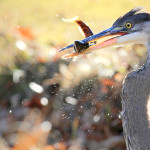
A collaborative study released yesterday involving scientists from the Cambridge Conservation Initiative has shown that climate change is altering species distributions and populations, seemingly through shifting interactions between species rather than direct responses to climate.

The study, led by the British Trust for Ornithology (BTO) and involving Fauna & Flora International, International Union for Conservation of Nature (IUCN), UNEP World Conservation Monitoring Centre, Royal Society for Protection of Birds and BirdLife International, as well as Cambridge University, reviewed almost 150 published studies of climatic impacts on natural populations.
An ecosystem is made up of a multitude of species interacting with each other. This study has shown that many of the climate-related impacts on a given species occur as a result of changes in population and behavior of other species within the ecosystem, which then cascade through the food chain.
For example, Arctic fox populations have been affected by declining lemming populations (which is linked to changes in snow cover) and by expanding red fox populations. In the UK, upland birds such as the golden plover are affected by increasing summer temperatures, which causes problems for their crane fly prey.
These disruptions particularly affect predatory species, and appear to have worsened with climate change. Dr James Pearce-Higgins of the BTO said, “Although it might be assumed that most species are responding directly to climatic changes, either as individuals move to keep within their favoured climate zone, or through survival and reproductive rates linked closely to these climatic variables, this does not account for the majority of impacts. Instead, the main impacts of climate change occur through altered interactions between species within an ecosystem.”
Importantly, since much conservation action is already about managing species’ populations (such as controlling invasive species or reducing predation risk), we already have the conservation tools in place to reduce the impacts of climate change on species.
This understanding therefore provides hope that we can help the most vulnerable species adapt to climate change—providing that the magnitude of climate change is not too great, and that conservation activity is sufficiently funded.
For example, in the UK uplands, degraded peatland habitats can be restored to boost invertebrate crane fly populations and increase their resilience to climate change.
Whilst this work also helps identify the types of species most vulnerable to climate change impacts, there remains a lack of information from the tropics, where most species occur. Increased monitoring and research in tropical regions will therefore be essential.
“This study highlights a need to consider the often complex ecological relationships between species when assessing the impacts of climate change on wildlife,” says Jamie Carr of the IUCN, a co-author on the study. “Most research to date has focused on the direct impacts of changing conditions, which may mean that important emerging threats are being overlooked.”
——–
YOU MIGHT ALSO LIKE
USGS Climate Change Study Predicts Bleak Future for Birds and Reptiles in Southwest
24 Percent of Europe’s Bumblebees Threatened With Extinction
Climate Change Causing Salamanders to Shrink, Leaving Them Vulnerable to Predators and Extinction
——–
[source: http://ecowatch.com/2014/04/15/climate-change-chain-reaction-ecosystems/]

Leave a Reply
You must be logged in to post a comment.